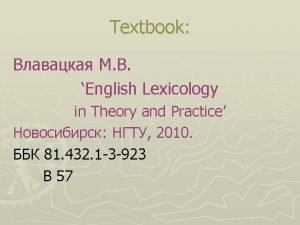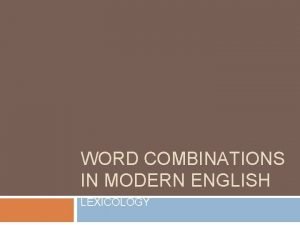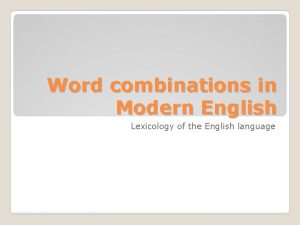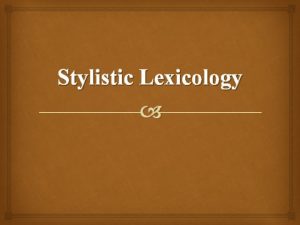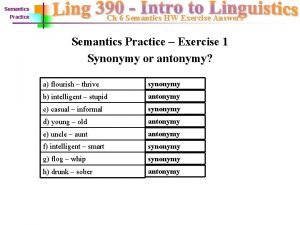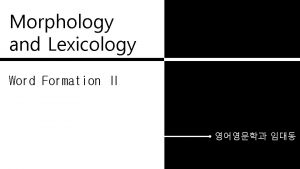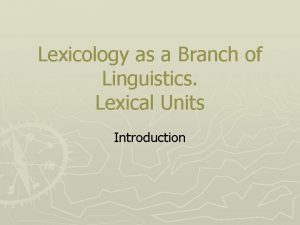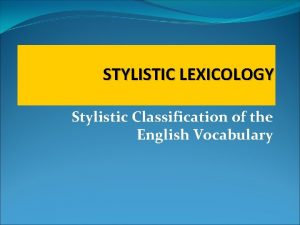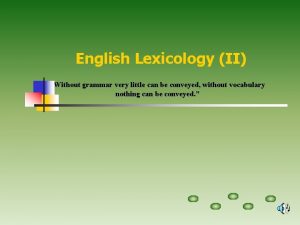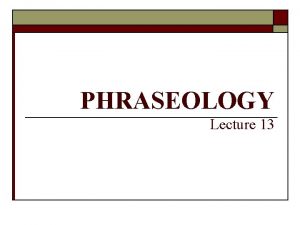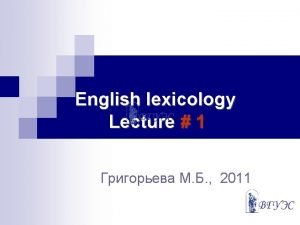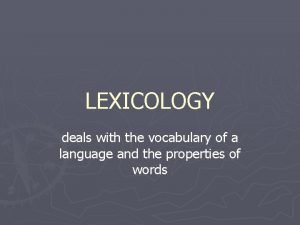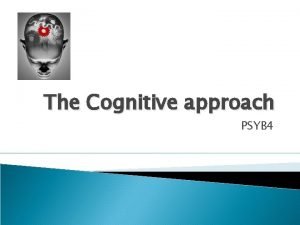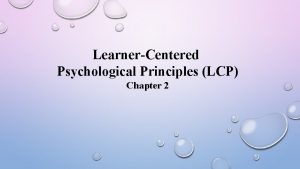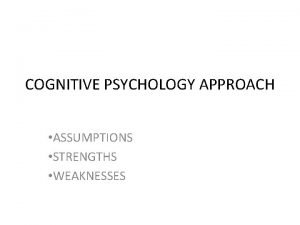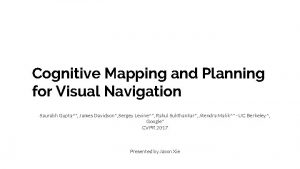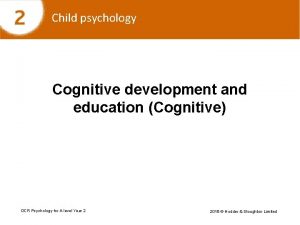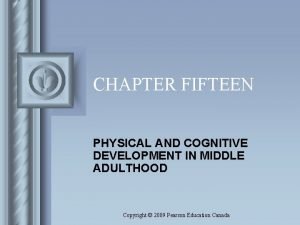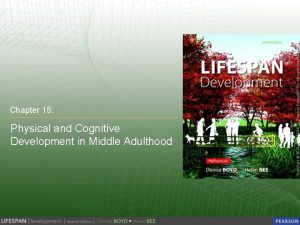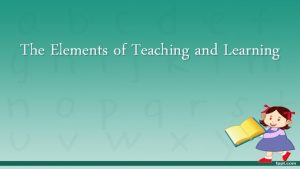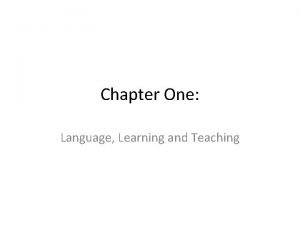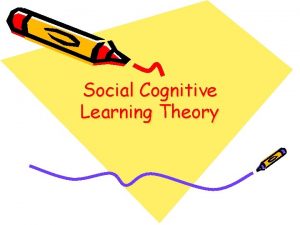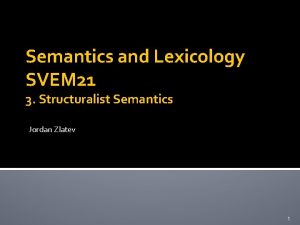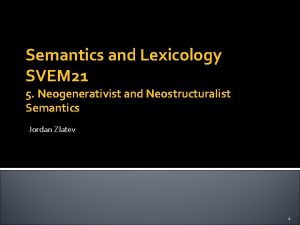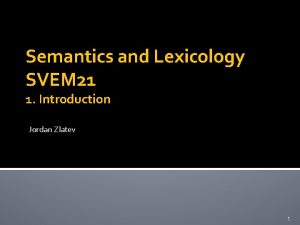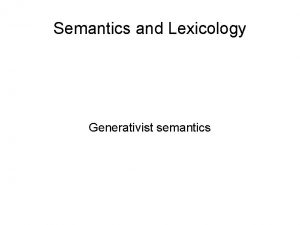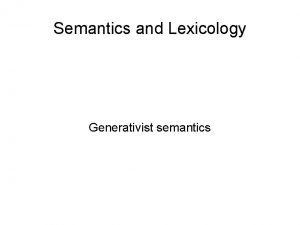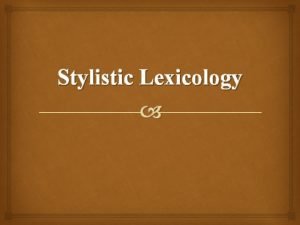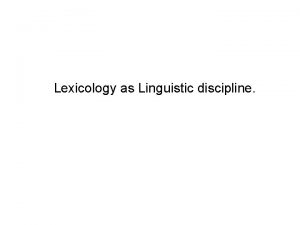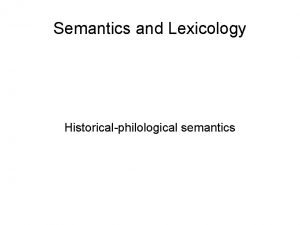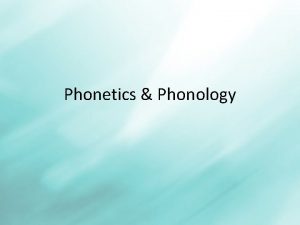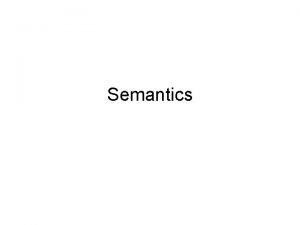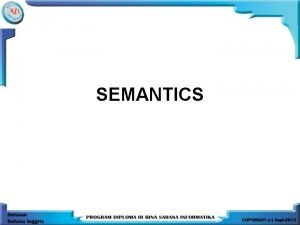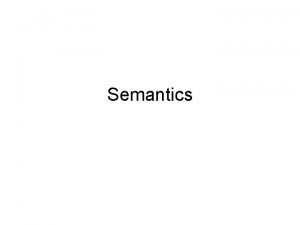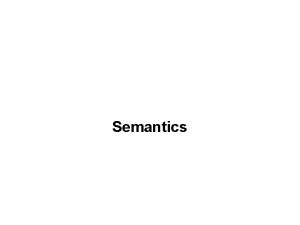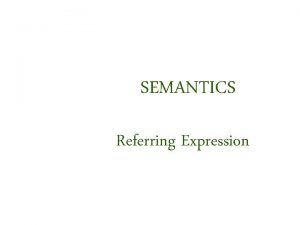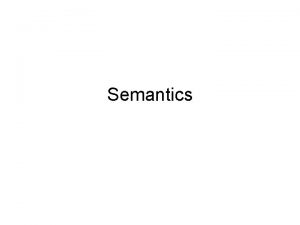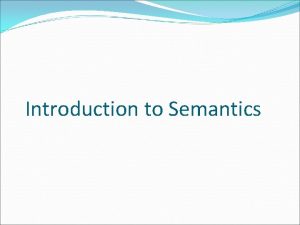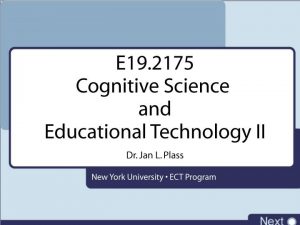Semantics and Lexicology SVEM 21 6 Cognitive Semantics
































- Slides: 32

Semantics and Lexicology SVEM 21 6. Cognitive Semantics Jordan Zlatev 1

Cognitive Semantics (as construed by Geeraerts) �Emerged in the 1980 s, as (the central) part of Cognitive Linguistics �“explicitly embraces a maximalist position: one in which the distinction between semantics and pragmatics is irrelevant in which language is seen in the context of cognition at large, In which language use is the methodological basis of linguistics - at least in principle. ” (: 182) 2

Geeraerts (2007) plenary lecture at the 10 th ICLC, Krakow �Three stages in Cognitive Linguistics/Semantics defined by certain “milestones” 1. Embodiment, ICMs (Lakoff 1987) 2. Sociocultural situatedness, dynamism (Zlatev 1997) 3. Onomasiological pragmatics (Geeraerts 2007) Unbiased? 3

“Four specific contributions” � 1. Prototypicality and salience � 2. Conceptual metaphor and metonymy � 3. Idealized Cognitive Models and Frames � 4. Usage and change � 5. Cognitive Semantics in Context Meaning in the mind Meaning in culture and society Meaning in text and discourse 4

1. Prototypicality and salience � Rosch et al: “prototyplicality effects” – the study of “categories”, not (lexical meanings) � Originally applied to perceptual categories (colors, natural kinds): “some natural categories are analog and must be represented logically in a manner which reflects their analog nature” (Rosch and Mervis 1975), (p. 186) � Influential, but questioned in psychology: Davidoff on color; Mandler on the distinction between perceptual and conceptual categories (ANIMATE, CAUSED MOTION, which are not “basic level”) � Extended boldly within Cognitive Semantics 5

1. Prototypicality and salience Extentional (exemplars) Intensional (definition) Non-equality (internal structure) (a) Differences in typicality (b) Family resemblances and membership salience Non-discreteness (demarcation problems) (c) Fuzziness in the edges, membership uncertainty (d) Absence of necessary and sufficient conditions (“classical definitions”) “Prototypicality, in short, is itself a prototypically clustered one…” (: 188) • fruit: all four feature • bird: (a), (b), (d) • odd number: (a) 6

1. Prototypicality and salience �Applied to the polysemy: “radial networks” “a cluster of mutually interrelated readings, concentrating around a core reading” (: 193) �Brugman (1981), Lakoff (1987, Case study 2) �See Figure 5. 4. (: 195) 7

1. Prototypicality and salience (1)The plane flew over. (Central schema) (2) The bird flew over the yard. (3) The plane flew over the hill. (4) The bird flew over the wall. (5) Sam drove over the bridge. (6) Sam walked over the hill. (7) Sam climbed over the wall. (2 -7: Extensions from 1) (8) Sausalito is over the bridge. (End-point focus from 5) (9) Sam lives over the hill. (End-point focus from 6) (10) Hang the painting over the table. (Central -> Above schema, from 1) (11)The powerline stretches over the yard. (Path -> 1 dim trajector from 2) 8

1. Prototypicality and salience � Problem: Which of these are different senses (polysemy) and which are contextual modulations (generality)? � Geeraerts (1993) + p. 196 -199: ”blurs and dynamizes the very distinction between polysemy and vagueness”: true? 9

1. Prototypicality and salience � What about onomasiology? “Can the concept of salience be transferred from the semasiological to the onomasiological domain? ” (: 200) � “Basic-level concepts” “…the basic level embodies a set of naming preferences: given a particular referent, the most likely name for that referent from among the alternatives provided by the taxonomy will be the name situated on the basic level” (: 200), See Fig. 5. 5. � Problem with terms for artifacts: “can be linked to various superordinate categories” (: 203) 10

1. Prototypicality and salience �“generalized onomasiological salience” can be equated with the notion of “entrenchment”? (: 201) – yes? �Operationally defined: frequency with which a category is named with a particular term / the total frequency of the category in the corpus Example: apple: 60% fruit: 10%, Granny Smith: 1% 11

2. Conceptual metaphor and metonymy � 1. “Metaphor is a cognitive phenomenon, rather than a purely lexical one” (: 204) �Unacknowledged precursor in the historicalphilological tradition �Generalize over many expressions (see p. 205) �Creative use: “the theory has a problem with its plumbing” �In gesture (Cienki), advertizing (Forceville), reasoning (Lakoff, Johnson)… 12

2. Conceptual metaphor and metonymy � 2. “Metaphor should be analyzed as a mapping between two domains” �LOVE IS A JOURNEY (p. 206) � The Conduit Metaphor (Reddy 1979), p. 206 �A taxonomy from Lakoff and Johnson (1980), given up afterwords Structural metaphors Ontological metaphors (X is an OBJECT/ PERSON) Orientational metaphors (MORE IS UP) 13

2. Conceptual metaphor and metonymy � 3. metaphor and “linguistic semantics is experientially grounded” (: 204) � “Embodiment” Image schemas: “embodied experiential gestalts” The directionality of metaphor “Metaphors allow us to understand one domain of experience in terms of another. ” (Lakoff 1987) ”Primary metaphors” (Grady 1997) are based on pre -linguistic, bodily experience 14

“Image schemas” CONTAINER, PATH, BALANCE, PART-WHOLE, FORCE… � Based on “bodily experience” (embodiment) � Gestalts – non-propositional, analog, topological and non-compositional – but with internal structure � Ground ”logical” thought – via metaphor If x is INSIDE (CONTAINER), it cannot be OUTSIDE (CONTAINER) � Dynamic (? ) 15

“Image schemas” Johnson & Rohrer (2007): “The English word “into” is understood via a superimposition of the Source-Path-Goal schema on the Container schema, as follows: - “in” activates a Container Schema with the interior profiled. - “to” activates a Source-Path-Goal schema with the destination (endpoint) profiled. The destination (endpoint) is mapped onto the interior of the container schema…” 16

2. Conceptual metaphor and metonymy: criticism � What are the “conceptual metaphors” (Haser 1995): ARGUMENT IS WAR/ FIGHTING /GAME-PLAYING…? � Many expressions are only “metaphoric from a diachronic point of view” (: 209) “dead metaphors”: I see, mountain foot “discourse metaphors”: bastion (Zinken 2007) � Psychological reality? (cf. 5. 4. 1 Meaning in mind) � How to define “domains”? � How to distinguish between metaphor and metonymy? � Static, “entrenched” mappings – creativity, context? 17

2. Metaphor and metonymy �Conceptual Integration (Blending) theory (Fauconnier and Turner 2002) �More complex metaphors: Grim Reaper �More than one input space, Fig 5. 6 �Greater flexibility (but also vaguer…) 18

2. Metaphor and metonymy �Conceptual metonymy: “allow us to think of of one thing in terms of its relation to something else” (: 214), see p. 214 �I love Motzart, Thatcher is the Reagan of the UK: metaphor or metonymy? Same or different domains? ) �Croft (1993): “domain matrix” �Dirven (1993): back to similarity vs. contiguity �Geeraerts: a prototype-based analysis of “contiguity” �Goossens (1990): “metaphtonomy”: catch someone’s ear, dirty fingers 19

3. ICMs and Frames �“An encyclopedic conception of meaning, then requires representing those larger chunks of meaning…” �Lakoff: ICM for bachelor (or single) – (“an iconic term in lexical semantics, as we have seen”, : 224) �Fillmore: Frames – referential situation (“scene”) + “more purely linguistic part of analysis… highlights aspects of that situation or event (“frame”), see 5. 8, Frame. Net 20

4. Usage and change � Invited inference and pragmatics (Traugott and Dasher 2005): Conventional meaning > utterance-token meaning (“Squirrel, I love you) Utterance-type meaning (“after” – causal) New conventional (“coded”) meaning: (“since”) � Geeraerts (: 232): “It is an illusion that this approach does away with the necessity of a fine-grained account of the possibilities of use of a word. ” Argument: “semantic polygenesis”? “the mechanism of contextual specification does not entirely explain the process of conventionalization” – Yes! 21

4. Usage and change �“a renewed interest in the possible regularity of semantic change” (: 235) �Traugott (1999) “subjectification”: must �Sweetzer (1990): metaphor (SEEING IS KNOWING), but far from universal (Vanhove 2008) �Heine and Kuteva (2002): grammaticalization – from “more to less” lexical meaning: NOUN > PREP, CARDINALS �Blank (1997): “all possible pathways” (Fig 5. 9) 22

5. 1. Meaning in the mind �Some overlap with psychology, neuroscience Gibbs (idioms, embodiment) Boroditsky (metaphor, fictive motion) Coulson (blending) Sinha (radial categories – language acquisition; cultural influence upon metaphor: Zapotec, Amondowa) �But little influence on “mainstream” psychology Gentner (metaphor through analogy + categorization) Glucksberg (metaphor as categorization) Murphy (2002): current categorization research 23

5. 2 Meaning in culture and society �“the sociohistorical situatedness of meaning” is needed as a corrective to excessive universalism, due to a narrow interpretation of “embodiment” �Geeraerts: the role of theory of the “four humors” for emotion terms: phlegmatic, foolblooded etc. �“Cultural models… are not reinvented afresh” (: 252) – but neither are they “arbitrary” 24

Case study: Motion-emotion metaphors �In speaking of emotional experiences, the self, or some relevant “part of the self” can be described as if being set in motion: (1) My spirits are rising (2) My mood is sinking. (3) I was attracted by her smile. 25

Comparison Language-to- English language overlap Swedish Bulgarian Thai English 38 (12*) 23 14 6 Swedish 21 27 (5*) 11 6 Bulgarian 13 11 19 (5*) 7 Thai 6 6 7 31 (24*) 26

Comparison 27

Constructivism (structuralism) � 46 motion-emotion metaphors: 12 for English, 5 for Swedish, 5 for Bulgarian and 24 for Thai were found to be language-specific. 28

Theory 1 (Embodied) universalism Metaphor type MOVE DOWN → NEGATIVE English Swedish Bulgarian Thai F drops F sjunker F pada F tòk-caj MOVE UP → POSITIVE F is rising F stiger C po-vdiga F F chuu-caj C krossar F C raz-biva F F caj-sàlǎaj C (om)skakar F C raz-tărsva F F sàtɯan-caj C upprör F C u-bărkva F C kuan-caj F BREAK UP → C shatters F VERY STRONG NEG. EMOTION SHAKE → C shakes F STRONG NEG. EMOTION STIR → C stirs F NEG. EMOTION 29

ory 3 ”Interactionism” � None of the 46 language-specific (and in a few cases form-specific) expressions can be called “arbitrary” � The degree of overlap between the metaphors in the four languages corresponds to the degree to which the languages/cultures are related: English and Swedish are most similar, both genetically and culturally. Bulgarian, a Slavonic language from South-Eastern Europe is more distant, while Thai is clearly the “outlier” in the group. 30

5. 2 “Models of normativity” �Keller: “The Invisible Hand” – norms do not operate with the blind necessity of “The Market” �Putnam: “Experts” vs. “stereotypes” (divisional of linguistic labor): semantic norms are more consensual than “authoritarian” �Bartsch: “highest norm of communication” and “lower norms” (= semantic conventions) �Itkonen (not mentioned!): mostly emphasized the latter, and that they constitute “language as a social institution” 31

5. 3. Meaning in text and discourse � “The essential idea of usage-based linguistics is the dialectic nature of the relation between language use and language system” (: 259) � … but then proceeds as if the latter should be eliminated! � “Actual usage”: The pragmatics of metaphor (the Pragglejaz group) “Computationally sophisticated” (Stefanowitch, Glynn…) “pragmatic onomasiology” – for change and usage, yes: “changes are always mediated on the level of onomasiological choices made on the level of parole” (: 265) But in general? 32
 Cognitive and non cognitive religious language
Cognitive and non cognitive religious language Compare procedural semantics and declarative semantics.
Compare procedural semantics and declarative semantics. Descriptive lexicology
Descriptive lexicology English lexicology theory and practice
English lexicology theory and practice Types of meaning
Types of meaning Types of word combinations
Types of word combinations Types of word combinations
Types of word combinations Stylistic lexicology
Stylistic lexicology Semantle answers
Semantle answers Partial conversion lexicology
Partial conversion lexicology Lexicology as a branch of linguistics
Lexicology as a branch of linguistics Introduction to lexicology
Introduction to lexicology Colloquial coinages examples
Colloquial coinages examples Blends and acronyms
Blends and acronyms Phraseological units examples
Phraseological units examples Descriptive lexicology
Descriptive lexicology Coinage lexicology
Coinage lexicology Cognitive psychology essay
Cognitive psychology essay Early adulthood cognitive development
Early adulthood cognitive development Middle and late childhood
Middle and late childhood Module 47 infancy and childhood cognitive development
Module 47 infancy and childhood cognitive development 6 principles of cognitive and metacognitive factors
6 principles of cognitive and metacognitive factors Cognitive approach strengths and weaknesses
Cognitive approach strengths and weaknesses Cognitive mapping and planning for visual navigation
Cognitive mapping and planning for visual navigation Cognitive development in education
Cognitive development in education Denny's model of physical and cognitive ageing
Denny's model of physical and cognitive ageing Denny's model of physical and cognitive ageing
Denny's model of physical and cognitive ageing Associative stage
Associative stage What are the elements of teaching and learning?
What are the elements of teaching and learning? Structural linguistic and behavioral psychology
Structural linguistic and behavioral psychology Labouvie-vief pragmatic thought
Labouvie-vief pragmatic thought Cognitive walkthrough and heuristic evaluation
Cognitive walkthrough and heuristic evaluation Cognitive factor examples
Cognitive factor examples



